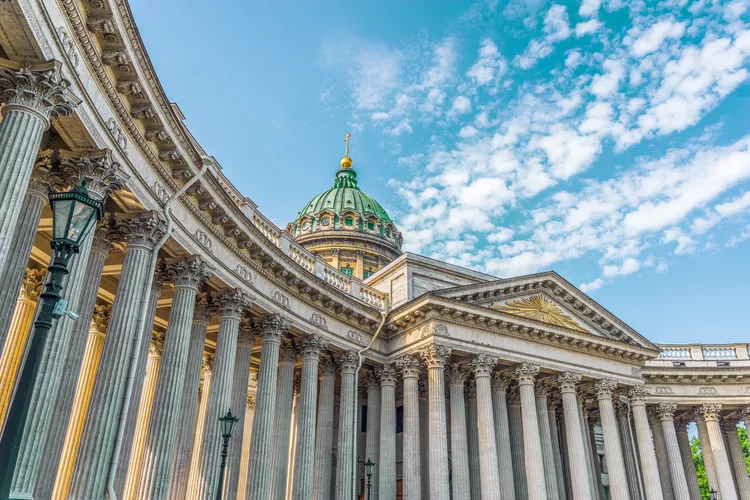Summary
Located in the heart of St. Petersburg, the Kazan Cathedral overlooks Nevsky Prospect, the most central street of the city. The Cathedral’s proximity to the colorful Church of the Spilt Blood means it is often overlooked by visitors to the city; however, this Orthodox Cathedral is a must-see. It is one of the most important historical and architectural sites of St. Petersburg, and its stunningly beautiful exterior and uniquely detailed interior make it a worthwhile visit for any traveler.
1. History
The Kazan Cathedral was built between 1801 and 1811. Designed by Andrey Voronikhin, it replaced a small decrepit church devoted to the Nativity of the Virgin Mary. Furthermore, the Cathedral was built to house a copy of an icon of Our Lady of Kazan.
Emperor Paul I envisioned the Kazan Cathedral resembling St. Peter’s Basilica in Rome, dreaming that St. Petersburg would become a northern Rome, serving as a powerful religious center with the Kazan Cathedral at its core. The grandeur of the cathedral symbolizes the greatness of St. Petersburg as the capital city and home to great emperors, architects, and artists during this era.
2. Secular History
When Napoleon’s army invaded Russia in 1812, the commander-in-chief of the Russian army, Mikhail Kutuzov, sought help from Our Lady of Kazan. Consequently, the Cathedral became a memorial to the Russian victory against Napoleon.
The Russian Revolution of 1917 and the creation of the Soviet Union led to the decline of all Russian religious buildings. The Kazan Cathedral was closed in 1932 and later reopened as a “Museum of Religion and Atheism,” resulting in disrepair and the removal of religious treasures.
3. Architecture
The Cathedral stands as one of the most significant political and architectural structures of St. Petersburg because it did not rely on imports; all materials used, along with the architect and workers, were of Russian origin.
The Cathedral’s stunning façade, featuring 96 columns arranged in a wide semicircle opening onto a stately garden, is actually the rear of the Cathedral, as the altar of an Orthodox church must face east. Two pedestals on either side of the colonnade stand empty today; they were intended to display two angel statues that were never constructed due to disagreements within the building committee over the best sculptor for the job.
4. Restoration
After the fall of Communism, many Russian churches were restored as religion regained acceptance. The interior and exterior of the Kazan Cathedral underwent restoration from 1950 to 1968, and religious services resumed in 1991. Importantly, the famous icon of Our Lady of Kazan was returned to the Cathedral in 2002.
5. Visiting the Cathedral
Things to notice:
- The Bas-Reliefs in the Exterior: Take a moment to admire the beautiful, detailed statues in the Cathedral’s façade.
- The Floor and Ceiling: The floor is covered in intricate mosaics, while the ceiling features striking frescoes and decorations. Pay special attention to the dome, which stands 71.6 meters tall and has a diameter of 17 meters, along with the figures painted around it.
- The Art on the Walls: The Cathedral houses a captivating collection of paintings, including a haunting portrayal of Jesus struggling under the weight of the cross and a uniquely bright and evocative representation of Christ instead of a traditional statue.
6. Getting There
The Kazan Cathedral is located on Nevsky Prospect 2, Kazanskaya Square. For convenient access, take the Metro to M. Nevsky Prospekt. Furthermore, you can visit the website for details on admission hours.
7. Tips for Visitors
- Women are encouraged to cover their hair while inside the Kazan Cathedral. Although not strictly mandatory, local visitors, who may be strictly Orthodox, tend to feel uneasy about women without head coverings. A simple scarf, hat, or hood will suffice.
- While it is permissible to enter the Cathedral during services, taking photos during a service may be considered rude.





